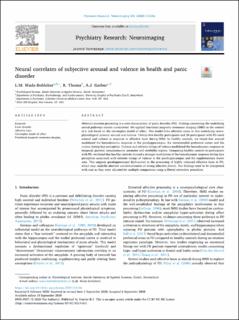Please use this identifier to cite or link to this item:
https://doi.org/10.21256/zhaw-20585| Publication type: | Article in scientific journal |
| Type of review: | Peer review (publication) |
| Title: | Neural correlates of subjective arousal and valence in health and panic disorder |
| Authors: | Wade-Bohleber, Laura Maria Thoma, R. Gerber, A.J. |
| et. al: | No |
| DOI: | 10.1016/j.pscychresns.2020.111186 10.21256/zhaw-20585 |
| Published in: | Psychiatry Research: Neuroimaging |
| Volume(Issue): | 305 |
| Issue: | 111186 |
| Issue Date: | 10-Sep-2020 |
| Publisher / Ed. Institution: | Elsevier |
| ISSN: | 0925-4927 1872-7506 |
| Language: | English |
| Subjects: | Affective faces; Circumplex model of affect; Functional magnetic resonance imaging; Panic disorder |
| Subject (DDC): | 616.8: Neurology, diseases of nervous system |
| Abstract: | Aberrant emotion processing is a core characteristic of panic disorder (PD). Findings concerning the underlying neural pathways remain inconsistent. We applied functional magnetic resonance imaging (fMRI) in the context of a task based on the circumplex model of affect. This model links affective states to two underlying neurophysiological systems: arousal and valence. Twenty-two healthy participants and 20 participants with PD rated arousal and valence in response to affective faces during fMRI. In healthy controls, we found that arousal modulated the hemodynamic response in the parahippocampus, the ventromedial prefrontal cortex and the cuneus during face perception. Valence and extreme ratings of valence modulated the hemodynamic response in temporal, parietal, somatosensory, premotor and cerebellar regions. Comparing healthy controls to participants with PD, we found that healthy controls showed a stronger modulation of the hemodynamic response during face perception associated with extreme ratings of valence in the parahippocampus and the supplementary motor area. This suggests parahippocampal dysfunction in the processing of highly valenced affective faces in PD, which may underlie aberrant contextualization of strong affective stimuli. Our findings need to be interpreted with care as they were adjusted for multiple comparisons using a liberal correction procedure. |
| URI: | https://digitalcollection.zhaw.ch/handle/11475/20585 |
| Fulltext version: | Published version |
| License (according to publishing contract): | CC BY-NC-ND 4.0: Attribution - Non commercial - No derivatives 4.0 International |
| Departement: | Applied Psychology |
| Organisational Unit: | Psychological Institute (PI) |
| Appears in collections: | Publikationen Angewandte Psychologie |
Files in This Item:
| File | Description | Size | Format | |
|---|---|---|---|---|
| 2020_Wade-Bohleber_etal_Neural-correlates.pdf | 1.57 MB | Adobe PDF |  View/Open |
Show full item record
Wade-Bohleber, L. M., Thoma, R., & Gerber, A. J. (2020). Neural correlates of subjective arousal and valence in health and panic disorder. Psychiatry Research: Neuroimaging, 305(111186). https://doi.org/10.1016/j.pscychresns.2020.111186
Wade-Bohleber, L.M., Thoma, R. and Gerber, A.J. (2020) ‘Neural correlates of subjective arousal and valence in health and panic disorder’, Psychiatry Research: Neuroimaging, 305(111186). Available at: https://doi.org/10.1016/j.pscychresns.2020.111186.
L. M. Wade-Bohleber, R. Thoma, and A. J. Gerber, “Neural correlates of subjective arousal and valence in health and panic disorder,” Psychiatry Research: Neuroimaging, vol. 305, no. 111186, Sep. 2020, doi: 10.1016/j.pscychresns.2020.111186.
WADE-BOHLEBER, Laura Maria, R. THOMA und A.J. GERBER, 2020. Neural correlates of subjective arousal and valence in health and panic disorder. Psychiatry Research: Neuroimaging. 10 September 2020. Bd. 305, Nr. 111186. DOI 10.1016/j.pscychresns.2020.111186
Wade-Bohleber, Laura Maria, R. Thoma, and A.J. Gerber. 2020. “Neural Correlates of Subjective Arousal and Valence in Health and Panic Disorder.” Psychiatry Research: Neuroimaging 305 (111186). https://doi.org/10.1016/j.pscychresns.2020.111186.
Wade-Bohleber, Laura Maria, et al. “Neural Correlates of Subjective Arousal and Valence in Health and Panic Disorder.” Psychiatry Research: Neuroimaging, vol. 305, no. 111186, Sept. 2020, https://doi.org/10.1016/j.pscychresns.2020.111186.
Items in DSpace are protected by copyright, with all rights reserved, unless otherwise indicated.